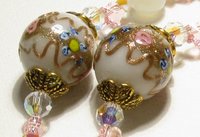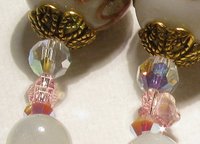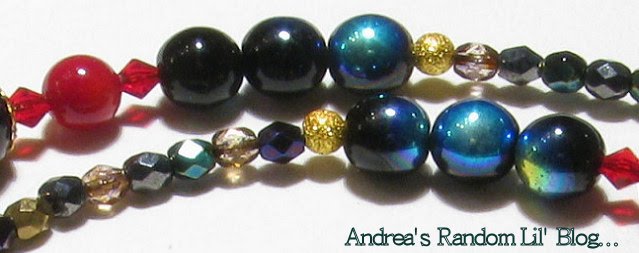The vintage fioratto beads also gave it a more traditional, conservative look, like an antique necklace. These beads I managed to win in an auction and I was very happy with them, since they are in perfect state, no chips of flaws whatsoever. I still have some left - I did not want to use them all because I think it is a pity to have lots of beads and some of them being inevitably hidden behind your neck or under the hair! I really think it's a waste, then I used some few where they are more visible and mixed it with gemstones and Swarovskis for that extra touch.
Here it is:
 For Fiore di Neve I have used:
For Fiore di Neve I have used:- Seven white vintage fioratto beads with gold foil and details in pink, yellow, blue and green;
- Eight medium white moonstone round beads;
- Several Swarovski crystal elements in different colours and sizes: round beads, flowers and bicones;
- Several Czech gold-lined clear seed beads;
- Antique gold bead caps for the fioratto beads;
- One clip gold-plated Swarovski clasp with embedded crystals.
Follows some details of this piece...


On these pictures we can see details of the white fioratto beads, along with the antique gold bead caps and some Swarovski elements (bicones, small flowers and round faceted beads). The 2nd picture also shows some of the nice gold-lined Czech seed beads, very small and delicate.



The 1st picture displays two of the moonstones along with lovely Swarovski Rose Water AB bicones, butterflies and faceted rounds. Moonstone is a type of feldspar that occurs in several shades and is characterised for that lovely opalescence and play of colours under different lights. This effect is known as Adularescence (from the Adula group of mountains in the European Alps) and moonstones are also called "Selenite" (from the greek Selene, Moon).
The 2nd and 3rd pictures were taken in the exact same position but using different lights. The so-called adularescence can be easily exemplified here and the surface of the stone is pretty much like soft snow reflecting the light.
One thing with moonstones is that they are very sensitive and have a low degree of hardness, meaning they can change appearance/texture under extreme heat and sweat and may break easily. Variations in texture can be easily fixed by a specialised jeweller though.


Another detail of the bead caps and Swarovski elements, while on the 2nd picture we can see the Swarovsky old-fashioned clasp, and more of the round faceted ones and gold-lined Czech beads.
Below, pictures of the necklace under different light settings:








This comment has been removed by the author.
ReplyDelete